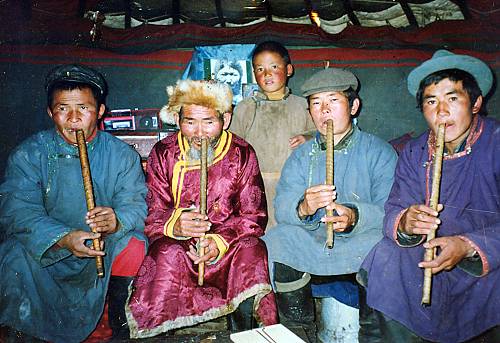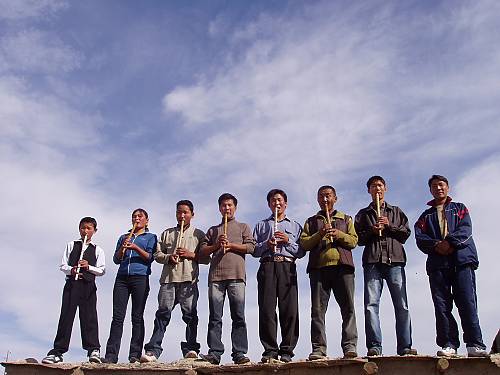List the key activities that were carried out during this reporting period in order to achieve these expected results. Please describe the activities in detail and note their effectiveness or any problems encountered in implementing them.
2009-2014 Mongolian Government has implemented successfully a several projects of the "Traditional music of the Tsuur” in the objectives to safeguard, develop, transmit the element to the next generation by training and apprenticeship, emphasize and support the “Tsuur” bearers. During the implementation of these projects relevant state and non-state parties, communities, practitioners have been involved actively and contributed an important role.
Activities
A: Field study and inventorying
- A field survey were undertaken to focus on the current state of Tsuur, its repertoire and associated customs and rituals
B: Safeguarding and Transmission
- The trainings of transmission of the Mongolian ‘Tsuur’ have conducted in Duut and Jargalant soum in Hovd province, Buyant, Ulgii and Ulaanhus sum in Bayan-Ulgii province, Sumber soum of Gobisumber province, Orkhon province and in the capital city between 2009 and 2012. The people who conducted the training were N.Buyandelger, son of famous ‘Tsuur’ player P.Narantsogt, B.Naranbat, the grandson, their relative B.Tseden-Ish, his student N.Sengedorj, N.Damdindorj, kazakh ‘Tsuur’ player A.Enbek and they used traditional apprenticeship training and classroom training methods. There are around 100 teenagers and young adults in nationwide who have learnt or leaning how to play this instrument as a result of these trainings. ‘Tsuur’ music apprenticeship training not only helps students to learn the method to play the ‘Tsuur’ instrument, but also requires students to know how to create ‘Tsuur’ instrument by themselves and gives them practical ‘Tsuur’ making experience.
- “Hunnu Tsuur Union” NGO and “Egshiglen Magnai” music instrument factory started to produce ‘Tsuur’ in a large amount and supplying the growing demand of ‘Tsuur’ music players and learners.
- UNESCO referred the Living Human Treasure program to its member countries. As a beginning of that program in the country, the national list “Talented people who inherited intangible Cultural heritage in high level” has approved by the Ministry of Education, Culture and Science in 2010 as their 546th order. The following 5 bearers; N.Buyandelger, B.Naranbat, N.Sengedorj, A.Enbek and A.Baldandorj have registered in that list as a ‘Tsuur’ bearers and it confirms that the heritage can survive and able to develop. The united budget funded these 5 people by 16 200 000 MNT to do apprenticeship program trainings and following supports were given to them.
- The work of making ‘Tsuur’ instrument as a major in professional art university has started in order to stabilize ‘Tsuur’ reputation in a family of Mongolian Traditional musical instruments. For this reason Cultural Heritage Center, Culture and Art University and Ulaanbaatar’s Music and Dance collage signed on cooperation agreement and started to work all together to supply with training materials and instruments, to plan syllabus and to acknowledge the training methods to the teachers who will teach.
- The Cultural Heritage Center published “Mongolian tsuur” DVD lesson and study books for ‘Tsuur’ music trainings. These training facilities were highly demanded among trainers, teacher, ‘Tsuur’ art bearers, music schools and professional art organizations and artists. It also became fruitful study materials to learn general ‘Tsuur’ music methods and traditional methods, to teach and disseminate.
C: Awareness raising, dissemination and promotion
- A book “Mongolian most rare traditional Intangible cultural Heritages” and “Mongolian Traditional Intangible cultural Heritages” published in Mongolian and English language for the dissemination work of traditional ‘Tsuur’ music in local and foreign countries. These books included ‘Tsuur’ instruments and its players photos, introductions and dissemination and research compositions.
- Many speeches related to Mongolian ‘Tsuur’ have presented in Science and Research meetings about the study of traditional art and culture in the country. Also similar speeches presented in “The V Grassland Culture Forum.2009” in Inner Mongolia of China, “Sounds of EURASIA” in Buriad’s Ulan-Ude in Russian Federation and in VII Congress-Festival.
- In 2013, we have organized a conference on "Tsuur music's actual situation and its difficulties" in Ulaanbaatar to discuss pertaining its future protection, development, art of ‘Tsuur’ making and related customs.
- Traditional Art Festival 2011, Oirad’s Art and Culture “Ikh Hogsuu” festival and “Altan Huree” Uriannhai’s yearly art, culture and sport festival which conducted by Urianhai’s History and Culture supporting Union all had bagpipe playing competitions. Many participants participated in these competitions and they were good encouragement to improve the abilities of the ‘Tsuur’ music players and increased their repertories.
- Mongolian National Broadcaster made television program “Golden Heritage” about Urianhai Tsuur music and its player,
- Eagle television made “Tsuur Heritage”, Ekh Oron television made “Urianhai tsuur tradition” and Mongolian National Radio made “Melody of the tsuur music”. All of these programs were good dissemination in the society. These television and radio dissemination programs were made during the report duration and together with previous art works they had big influence on recovering, supporting and creating good environment for ‘Tsuur’ music art development.
- The previous art works are: “Shuudriin Dusal” tele-program, “Hunnu’s wooden tsuur instrument” and “Melody of tsuur music” documentary movies and “Echo of Mountains and Waters” audio CD.










